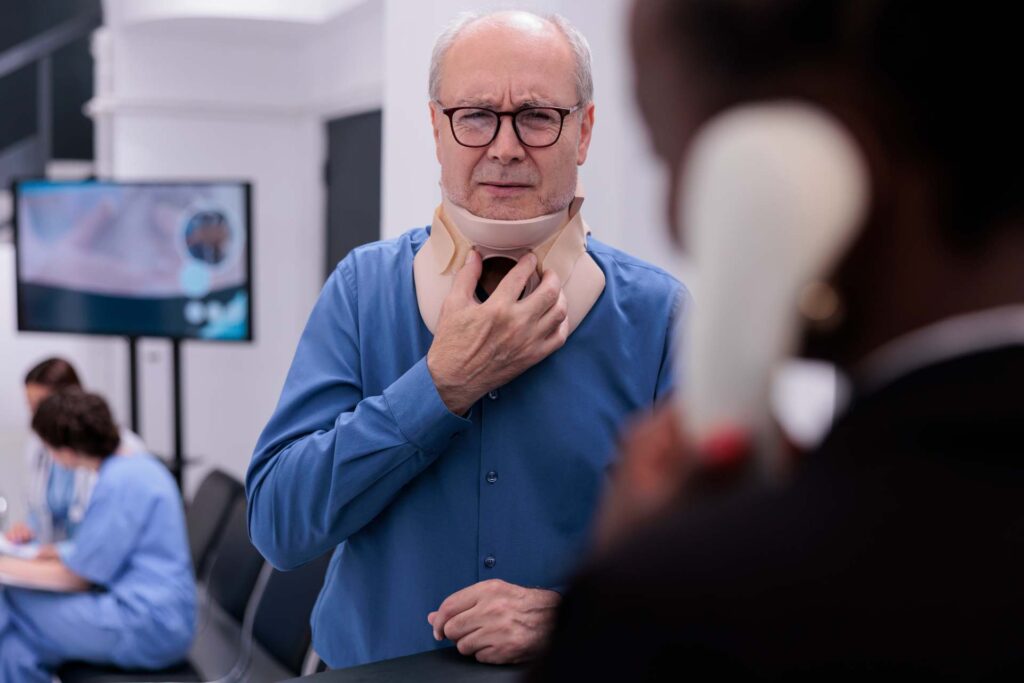
What Is Whiplash and How Does It Affect the Body?
Whiplash occurs when the neck is suddenly jerked forward and then backward, stretching and straining the muscles, ligaments, and joints in the neck and upper back. This rapid movement can lead to a variety of symptoms, which may develop immediately or in the days following the injury.
When whiplash happens, the soft tissues in the neck get overstretched, leading to small tears, inflammation, and swelling. In more severe cases, the discs in the spine can be damaged, or nerves may be compressed, leading to more widespread pain.
Common symptoms of whiplash:
- Neck pain and stiffness
- Reduced range of motion in the neck
- Headaches, often starting at the base of the skull
- Dizziness or vertigo
- Fatigue
- Pain or tenderness in the shoulders, upper back, or arms
- Tingling or numbness in the arms
Without proper treatment, whiplash can lead to chronic pain or long-term damage, which is why early intervention is essential. This is where physical therapy becomes a key part of recovery, helping patients regain their strength and mobility while managing pain.
How Physical Therapy Helps in Whiplash Recovery

Key benefits of physical therapy for whiplash recovery include:
- Pain relief and management: Techniques like manual therapy, stretching, and controlled movements help alleviate neck and shoulder pain.
- Restoration of mobility: Exercises designed to gently stretch and move the neck improve flexibility and range of motion.
- Muscle strengthening: Strengthening exercises for the neck, shoulders, and upper back help support the spine and prevent future injury.
- Posture correction: Physical therapy can improve posture, reducing the strain on the neck and minimizing discomfort during daily activities.
- Prevention of chronic symptoms: Ongoing therapy can reduce the risk of long-term problems such as headaches, dizziness, and chronic neck pain.
- Improved healing: Therapeutic exercises and modalities like heat or cold therapy promote circulation and aid tissue healing.
Techniques Used in Physical Therapy for Whiplash
A physical therapist will use a variety of techniques to treat whiplash, all tailored to the severity of the injury and the patient’s specific symptoms. These techniques are designed to be gentle yet effective in reducing pain and improving function.
Some common techniques include:
- Stretching exercises: These are designed to improve flexibility and reduce stiffness in the neck and upper back.
- Range-of-motion exercises: These help to restore normal movement in the neck by encouraging gentle, controlled movements.
- Strengthening exercises: Targeted exercises to build up the muscles around the neck and shoulders, offering more support and stability to the injured area.
- Manual therapy: This involves hands-on techniques like massage or joint mobilization to reduce pain and improve mobility.
- Posture correction: Physical therapists often work on correcting posture to reduce strain on the neck, which can help alleviate pain and prevent future injury.
Each treatment plan is unique, with exercises and techniques selected based on the individual’s condition, ensuring the most effective path to recovery.
How Long Does It Take to Recover from Whiplash with Physical Therapy?
The timeline for whiplash recovery can vary widely, depending on the severity of the injury and how soon treatment begins. For some, recovery may only take a few weeks, while others may need months of consistent physical therapy before they feel fully healed.
In most cases, individuals begin to see improvement within the first few weeks of therapy, with continued progress over time. Consistency is key in physical therapy, as regular sessions help build strength and improve mobility. It’s important to note that recovery is gradual, and even if symptoms seem mild, sticking with your treatment plan can prevent long-term issues.
Factors that affect recovery time:
- Severity of the injury
- How quickly treatment begins
- Consistency in attending physical therapy sessions
- Adherence to at-home exercises
Physical therapy offers a structured and safe way to recover, helping you progress at a steady pace without risking further injury.
Can Physical Therapy Help Prevent Chronic Whiplash Pain?
One of the biggest concerns after a whiplash injury is the possibility of developing chronic pain. This occurs when the injury doesn’t heal properly, leading to persistent neck pain, stiffness, or headaches that can last for months or even years. Physical therapy plays a crucial role in preventing this.
By improving flexibility, strength, and posture, physical therapy helps to reduce the risk of chronic pain by promoting full recovery. Patients who follow their physical therapist’s recommendations, including attending sessions regularly and performing exercises at home, are more likely to experience long-term relief and avoid lingering pain.
Can Physical Therapy Alone Treat Whiplash?
Physical therapy alone can be highly effective in treating whiplash, particularly for mild to moderate cases, by addressing pain, restoring mobility, and strengthening muscles. For many patients, a consistent physical therapy regimen can resolve symptoms without the need for additional interventions. However, the severity of the injury and individual factors, such as the presence of underlying conditions, can influence the effectiveness of physical therapy alone.
In more severe cases, or when symptoms persist despite therapy, a combination of treatments may be necessary. This can include chiropractic care, pain management techniques, or even medications to alleviate inflammation and discomfort. Physical therapy remains a core part of the recovery process but is often complemented by other approaches to fully address the injury.
Comprehensive Whiplash Care at AICA Orthopedics
Recovering from whiplash can be challenging, and at AICA Orthopedics, we’re dedicated to offering comprehensive care tailored to each patient’s unique needs. Our expert team—comprising chiropractors, physical therapists, and spine specialists—collaborates to create a personalized treatment plan that may include physical therapy, chiropractic care, and, in more severe cases, orthopedic or spine surgery.
Most whiplash cases can be effectively treated with our non-invasive options, avoiding the need for surgery. After assessing the severity of your injury, our team will recommend a treatment plan aimed at helping you recover as quickly and effectively as possible. If you’re dealing with whiplash symptoms, don’t hesitate—contact your nearest AICA Orthopedics today for an evaluation and begin your path to recovery with compassionate, expert care.
